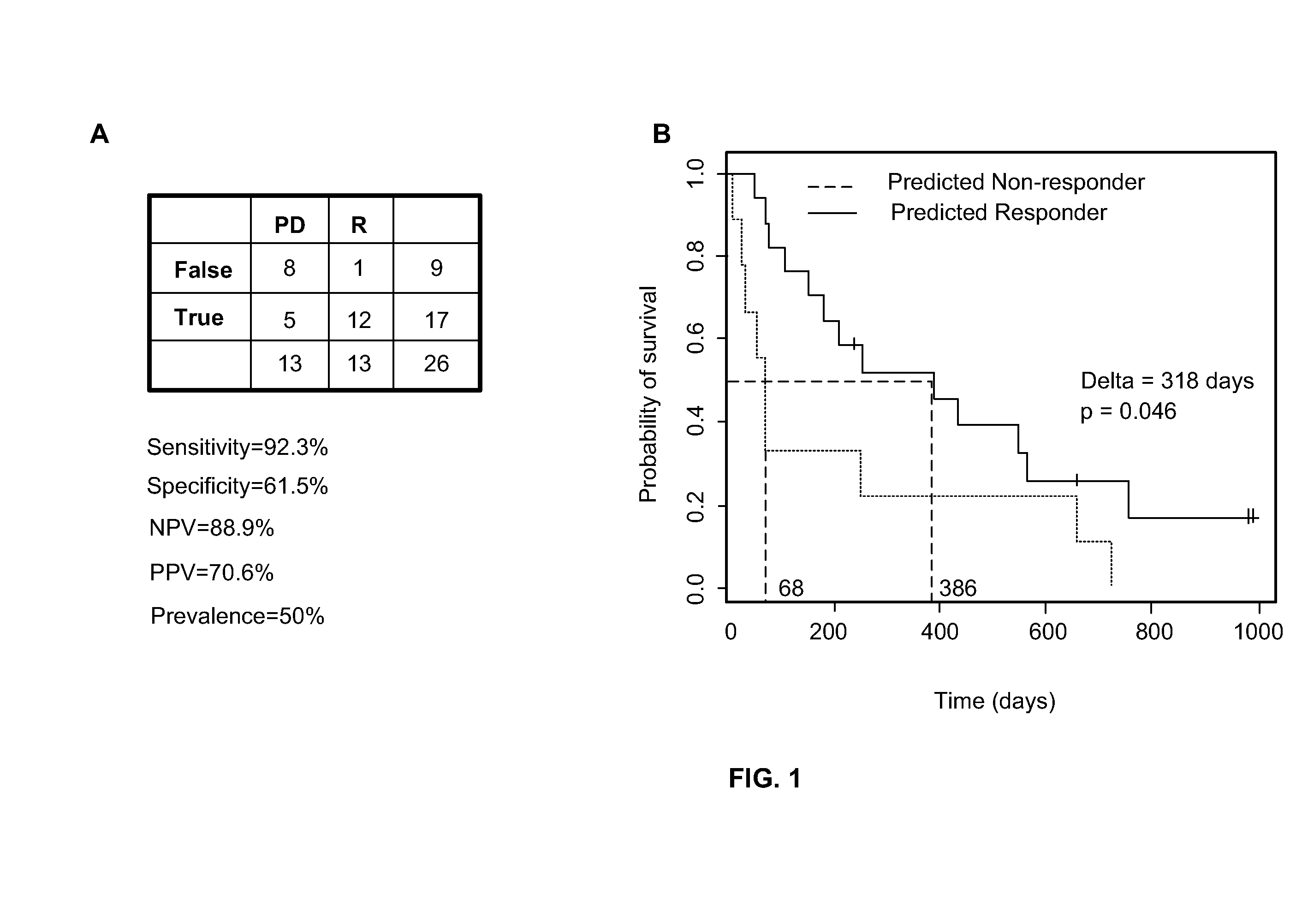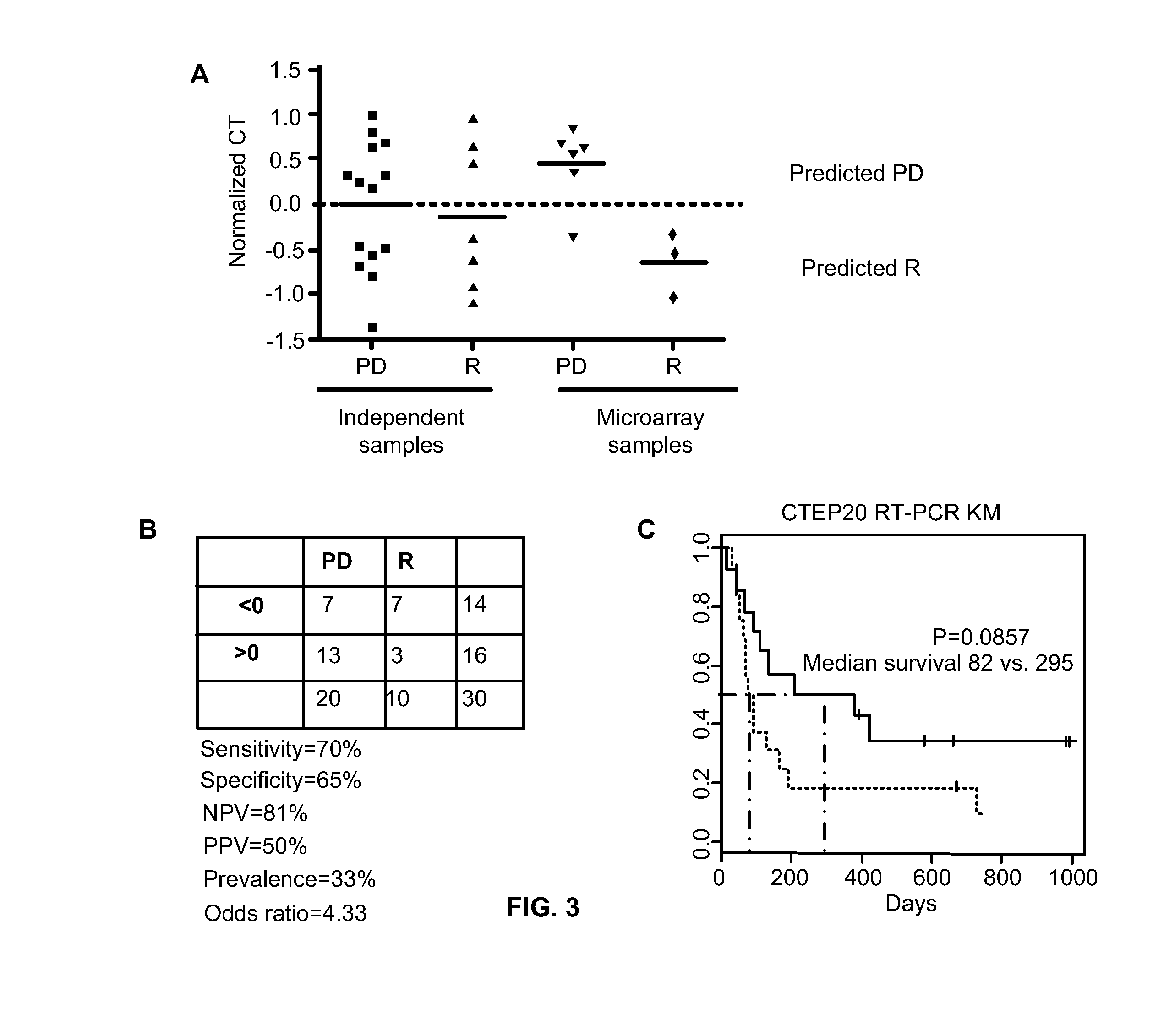Method of determining acute myeloid leukemia response to treatment with farnesyltransferase inhibitors
a farnesyltransferase inhibitor and acute myeloid leukemia technology, applied in the field of acute myeloid leukemia response to treatment with farnesyltransferase inhibitors, can solve the problems of increasing the prevalence of aml, affecting the survival rate of aml patients, and presenting many challenges in managing the treatment of elderly aml patients, so as to achieve rapid assay and predictive utility in identifying
- Summary
- Abstract
- Description
- Claims
- Application Information
AI Technical Summary
Benefits of technology
Problems solved by technology
Method used
Image
Examples
example 1
Materials and Methods
[0092]In an exemplary example, bone marrow samples are collected from an open label, multicenter, non-comparative phase 2 study investigating the efficacy and safety of farnesyltransferase inhibition with tipifarnib (R115777, ZARNESTRA®) in older adults with previously untreated, poor-risk AML.
Sample Collection and Processing
[0093]Bone marrow samples were collected from consenting patients before treatment with tipifarnib followed by mononuclear cells preferably being processed on site. Bone marrow aspirates were diluted with PBS and centrifuged with ficoll-diatrizoate (1.077 g / ml). Enriched leukemic blood cells were washed twice with PBS, resuspended in FBS with 10% DMSO and immediately frozen at −70° C. to −80° C. Total RNA was extracted from cell samples using the Trizol Kit (Qiagen, Santa Clarita, Calif.). RNA quality may be determined by assessing the presence of ribosomal bands on an Agilent Bioanalyzer. Good quality samples were further...
example 2
[0112]This example describes an improved RT-PCR assay suitable for applying the two-gene assay to FTI combination therapy. During the analytical assay development Taqman assays for 3 markers: RASGRP1 (guanine nucleotide exchange factor that activates RAS), APTX (aprataxin involved in DNA excision repair) and HMBS (used as an internal control) were designed. HMBS could be used as a control in an embodiment or be dispensed with in other embodiments. Sequences of Taqman primer probe sets and their amplicons are listed above in the Summary section and in the Sequences Section of this disclosure. Namely, for APTX-SEQ #3-4 and 2, RASGRP1 primer probe set SEQ #56 and 1; and HMBS-SEQ #7-9.
[0113]Quantitative RT-PCR assays were developed and optimized using ABI-7500 platform to assess the 2-gene ratio performance with FAM-labeled RASGRP1, Gold 540-APTX and Cy5-HMBS in a single-tube triplex format. JY cellular RNA and Universal RNA (Stratagene) were used as external normalization.
RASGRP1:APTX ...
example 3
[0135]This example shows the two-gene assay is effective in newly diagnosed AML patients. The 2-gene response predictive assay was tested first on leukemic blasts from a subset of 84 newly diagnosed AML patients enrolled in Phase 1 dosing study of tipifarnib and etoposide using the technical RT-PCR protocol described in Blood 2008, 111:2589. The clinical plan of Phase 1 trial is described in Blood 2009, 113:4841.
[0136]Briefly, fifty-one (51) unpublished evaluable patient samples from this study were analyzed for a preliminary assessment of the performance of the 2-gene assay. Table 11 summarizes the results using a threshold of 5 with RR standing for the response rate with responders exhibiting CR or PR, PPV for positive predictive value and NPV for the negative predictive value. 13 out of 51 patients responded for an RR of about 0.25. Among those who exceeded the threshold of 5 of the two-gene assay, half (9 out of 18) responded resulting in a PPV of about 0.5. Of the patients who ...
PUM
 Login to View More
Login to View More Abstract
Description
Claims
Application Information
 Login to View More
Login to View More - R&D
- Intellectual Property
- Life Sciences
- Materials
- Tech Scout
- Unparalleled Data Quality
- Higher Quality Content
- 60% Fewer Hallucinations
Browse by: Latest US Patents, China's latest patents, Technical Efficacy Thesaurus, Application Domain, Technology Topic, Popular Technical Reports.
© 2025 PatSnap. All rights reserved.Legal|Privacy policy|Modern Slavery Act Transparency Statement|Sitemap|About US| Contact US: help@patsnap.com



